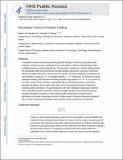| dc.contributor.author | Newberry, Robert W. | |
| dc.contributor.author | Raines, Ronald T | |
| dc.date.accessioned | 2020-11-20T19:08:55Z | |
| dc.date.available | 2020-11-20T19:08:55Z | |
| dc.date.issued | 2019-06 | |
| dc.identifier.issn | 1554-8929 | |
| dc.identifier.issn | 1554-8937 | |
| dc.identifier.uri | https://hdl.handle.net/1721.1/128549 | |
| dc.description.abstract | © 2019 American Chemical Society. A complete inventory of the forces governing protein folding is critical for productive protein modeling, including structure prediction and de novo design, as well as understanding protein misfolding diseases of clinical significance. The dominant contributors to protein folding include the hydrophobic effect and conventional hydrogen bonding, along with Coulombic and van der Waals interactions. Over the past few decades, important additional contributors have been identified, including C-H···O hydrogen bonding, n→π∗ interactions, C5 hydrogen bonding, chalcogen bonding, and interactions involving aromatic rings (cation-π, X-H···π, π-π, anion-π, and sulfur-arene). These secondary contributions fall into two general classes: (1) weak but abundant interactions of the protein main chain and (2) strong but less frequent interactions involving protein side chains. Though interactions with high individual energies play important roles in specifying nonlocal molecular contacts and ligand binding, we estimate that weak but abundant interactions are likely to make greater overall contributions to protein folding, particularly at the level of secondary structure. Further research is likely to illuminate additional roles of these noncanonical interactions and could also reveal contributions yet unknown. | en_US |
| dc.description.sponsorship | NIH (Grant R01-GM044783) | en_US |
| dc.language.iso | en | |
| dc.publisher | American Chemical Society (ACS) | en_US |
| dc.relation.isversionof | http://dx.doi.org/10.1021/acschembio.9b00339 | en_US |
| dc.rights | Article is made available in accordance with the publisher's policy and may be subject to US copyright law. Please refer to the publisher's site for terms of use. | en_US |
| dc.source | PMC | en_US |
| dc.title | Secondary Forces in Protein Folding | en_US |
| dc.type | Article | en_US |
| dc.identifier.citation | Newberry, Robert W. and Ronald T. Raines. "Secondary Forces in Protein Folding." ACS Chemical Biology 14, 8 (June 2019): 1677–1686 © 2019 American Chemical Society | en_US |
| dc.contributor.department | Massachusetts Institute of Technology. Department of Chemistry | en_US |
| dc.relation.journal | ACS Chemical Biology | en_US |
| dc.eprint.version | Author's final manuscript | en_US |
| dc.type.uri | http://purl.org/eprint/type/JournalArticle | en_US |
| eprint.status | http://purl.org/eprint/status/PeerReviewed | en_US |
| dc.date.updated | 2020-11-19T17:53:33Z | |
| dspace.orderedauthors | Newberry, RW; Raines, RT | en_US |
| dspace.date.submission | 2020-11-19T17:53:35Z | |
| mit.journal.volume | 14 | en_US |
| mit.journal.issue | 8 | en_US |
| mit.license | PUBLISHER_POLICY | |
| mit.metadata.status | Complete | |
